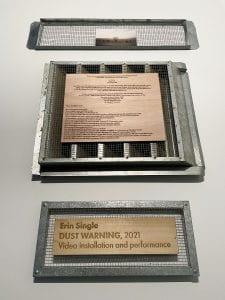DUST WARNING
(Does Albemarle know about this?)
DUST WARNING (Does Albemarle know about this?) is a project that considers our dependency on the metal lithium. Lithium is the lightest metal on Earth and an unseen material in most of our electronic devices. Lithium is critical to our consumption and creation of digital media. It is fundamental to the advancement of renewable energy technology to combat climate change, with the capacity to store wind and solar energy and power electric cars. Lithium is also a mood stabilizer in the treatment of bipolar disorder and manic depression. The project draws attention to the tension between a seemingly “green” raw material that is destructive to land, ecosystems, and people.
There is only one active lithium mine in the United States—the Silver Peak mine in Thacker Pass, Nevada—operated by the multinational mining corporation, Albemarle. By staging a performance at an estranged symbol of corporate power—the boardroom table—the work is a critique of extractive capitalism, and offers a playful alternative to internal and external landscapes where capital is felt but not seen.


Wall Text:
“The future always looks good in the golden land, because no one remembers the past.” —Joan Didion, “Some Dreamers of the Golden Dream” _________________ Silver Peak Discovered 1863 Silver Peak is one of the oldest mining areas in Nevada. A 10 stamp mill was built in 1865 and by 1867 a 20 stamp mill was built. Mining camp lawlessness prevailed during the late sixties, and over the next 38 years, Silver Peak had its ups and downs. In 1906 the Pittsburg Silver Peak Gold Mining Company bought a group of properties, constructed the Silver Peak Railroad and built a 100 stamp mill at Blair the following year. The town, at times, was one of the leading camps in Nevada, but by 1917 it had all but disappeared. The town burned in 1948 and little happened until the Foote Mineral Company began their extraction of lithium from under the floor of Clayton Valley. —State Historical Marker No. 155 Nevada State Park System By: Harold C. Hendersen _________________ Where does lithium “live”? Lithium is the lightest metal on Earth. Lithium is highly reactive and floats on water. If you made a fire with lithium, it would never go out. Lithium is present in ocean water. It is mined from brines and clays in salt flats and solid rock, like spodumene and petalite. Lithium-ion batteries are found in electric cars, storage units for wind and solar energy, and most consumer electronics, including laptops, smartphones, digital cameras, and sound recording devices. Lithium is used in the manufacturing of ceramics and glass. Lithium has two stable isotopes, Li-6 and Li-7, the latter of which is 92.5% abundant in nature. Lithium-6 is a critical raw material for producing tritium used in thermonuclear weapons. Lithium carbonate is used as a medicine to treat bipolar disorder and manic depression. There are only 8 lithium-producing countries. Most of the lithium mined from spodumene comes from Australia. Most of the lithium mined from brine comes from Chile, Argentina, and Bolivia, in an area known as “The Lithium Triangle.” The lithium market is an oligopoly. Five mining companies, Albemarle (US) along with Ganfeng Lithium (China), SQM (Sociedad Quimica y Minera de Chile S.A.), Tianqi Lithium (China), and Livent (US) control over 70% of the world’s lithium supply. The global supply for lithium is expected to triple by 2025 due to increased mining activity and demand for batteries and electric cars. Albemarle’s Silver Peak mine will double its production of lithium carbonate by 2025.
I excavate the content of lithium in a performance with two Califone record players. Using the materiality of grooves on a record and analog machines to expand and condense layers of time and noise, I create a sonic landscape that explores different mood states and the geopolitical and social strata of mining.


Erin Single is an artist and designer from Atlanta, Georgia.
Through video, installation, and performance, Erin creates ambient, surreal environments that explore liveness and location. She uses the theory of activist neuroaesthetics to estrange the environment and open up our minds to seeing alternatives to critical environmental issues such as extractive capitalism. She is currently pursuing an MFA in Digital Arts and New Media at the University of California, Santa Cruz, and prior to that she studied graphic design at the Savannah College of Art and Design. She also has a business degree from Emory University. In her previous life, she worked as a strategy consultant advising pharmaceutical and biotech companies in Berlin, Zürich, New York City, and Philadelphia.
Runtime: 8:37